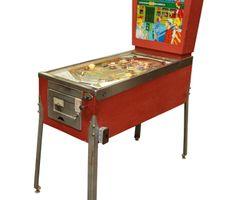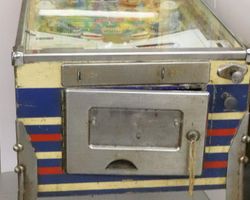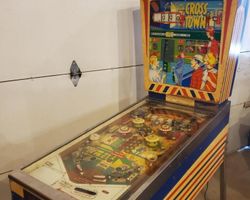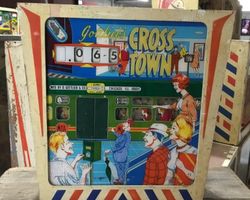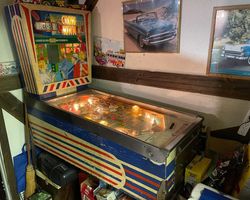Cross Town
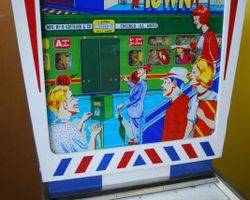
Average Prices: USD $500 to $1,300
Produced: September, 1966
Production Run: 2,765 units
Machine Type: Electro-mechanical
Players: 1
Design by: Ed Krynski
Art by: Art Stenholm
D. Gottlieb & Co. released "Cross Town" in September 1966, an electro-mechanical (EM) pinball machine that offered players a vibrant cityscape experience. With a production run of 2,765 units, this single-player game emerged as a notable entry in Gottlieb’s mid-sixties catalog, contributing to the manufacturer's reputation for innovative and engaging EM designs. The machine's concept and design were primarily shaped by Ed Krynski, who was also credited for the animation and mechanical elements. The distinctive visual appeal, a hallmark of Gottlieb machines, was crafted by artist Art Stenholm, whose work infused the game with a compelling "city living" theme. "Cross Town" is also significant for being one of the final Gottlieb machines, alongside its add-a-ball variant "Subway," to feature a manual ball-lift mechanism, a characteristic that defines a certain era of pinball design. Curiously, early sample versions of "Cross Town" featured subtle distinctions on the playfield and backglass compared to the production models, including differences in the "Special" insert color and specific textual elements, details that reveal the iterative nature of pinball machine development.
Signature Features and Design
"Cross Town" distinguishes itself through a blend of mechanical ingenuity and compelling artwork. The machine's backglass is a focal point, featuring a captivating mechanical animation of subway doors opening and closing. This unique visual element is not merely decorative; it serves as an engaging complement to the urban theme, adding a layer of dynamic storytelling that drew players into its world. The artwork by Art Stenholm, consistent across both the playfield and backglass, showcases a classic, colorful aesthetic that is widely appreciated for its beauty and fun depiction of city life. The robust manual ball-lift mechanism, a testament to the era's engineering, offered a tactile experience different from later automatic plungers, contributing to the machine's solid build quality. Accompanying the visual spectacle, the sound package, comprising three distinct bells and a loud knocker, provided satisfying auditory feedback for points and milestones, enhancing the player's sensory engagement with every successful shot.
Playfield and Mechanics
The "Cross Town" playfield is a carefully structured arena designed for challenging, fast-paced play. It features a pair of flippers at the bottom, notable for their wide separation, a design choice that profoundly influences gameplay dynamics. Above the flippers, two slingshots flank the central area, directing errant balls back into the action. The upper playfield is dominated by four pop bumpers, positioned to create a lively, "machine-gun like" action when activated. Two passive bumpers further define ball trajectories. Strategically placed are three standup targets, with a central target serving as a critical objective. A single rollunder lane adds another pathway for scoring.
The design philosophy behind "Cross Town" emphasizes an open playfield that, despite its apparent simplicity, offers surprising action. The ball moves at a good pace, demanding precise flipper work and strategic nudging. Art Stenholm's vibrant artwork adorns the playfield, illustrating the city theme with detailed graphics that integrate seamlessly with the game's objectives. Lighting elements, such as the "Last Ball in Play" indicator on the backglass and illuminated ball guides adjacent to the upper side rollovers, provide visual cues crucial for tracking progress and identifying opportunities for a Special award. The layout, while bearing some resemblance to Gottlieb's earlier 1961 "Flipper Fair," establishes its unique identity through specific target arrangements and its defining wide flipper gap.
Gameplay Dynamics
"Cross Town" offers a challenging yet rewarding gameplay experience rooted in its electro-mechanical scoring system and objectives. The primary goal involves lighting all four top rollover lanes to activate the pop bumpers and, occasionally, illuminate the upper side rollovers for a Special award, indicated by the lighting of normally-dark ball guides. A central strategic element revolves around the three standup targets, particularly the central target, which is key to scoring. Hitting this target can award 10 points or, when aligned with specific red and yellow lights, a paired point value that can sometimes lead to a Special on a random basis. Achieving this light alignment is a demanding task, often disrupted by the chaotic action of the pop bumpers.
The wide flipper gap is a defining characteristic of "Cross Town" gameplay, making it a "tough" and "punishing" machine. This significant gap frequently leads to drains, compelling players to master precise flipper timing and, crucially, skillful nudging. Effective nudging is not merely an optional technique; it is an essential strategy for controlling ball movement, lining up shots, and preventing frequent outlane drains. The game’s objective-based progression, while straightforward compared to later solid-state machines, provides ample strategic depth. Players must decide whether to focus on lighting lanes for pop bumper activity, aim for the challenging center target alignment, or simply survive the fast-moving ball in an effort to accumulate points. The game accommodates 3 or 5-ball play, with a tilt penalty resulting in an immediate game over. Scoring is displayed on mechanical reels, with a maximum visible score of 1,999 points before rolling over.
Reception and Legacy
"Cross Town" has garnered a consistently positive reception within the pinball community, often described as a classic and an enduring "keeper" for those who appreciate electro-mechanical machines. Its strengths are frequently cited, beginning with its aesthetic appeal: the artwork is consistently praised as beautiful, classic, and engaging, enhancing the theme's execution. The mechanical backbox animation of the subway doors is a significant highlight, considered a major draw and a unique, well-executed feature that adds charm and visual depth. The robust build quality, emblematic of Gottlieb's manufacturing standards, ensures the machine's longevity.
Gameplay-wise, the machine is celebrated for its challenging nature. While the wide flipper gap is the most frequently mentioned characteristic and can be a source of frustration for newcomers, it is also seen as a positive by many experienced players, contributing to the game's addictiveness and rewarding precision. The "machine gun-like" action of the pop bumpers and the satisfying auditory feedback from the bells and knocker are also highly regarded. Players appreciate the strategic depth offered by the objectives, particularly the pursuit of Specials through the top rollover lanes and the elusive center target alignment.
However, "Cross Town" is not without its critical points. The wide flipper gap, while a strength for some, remains the most common criticism, leading to frequent and often unavoidable drains for others. Some players also perceive the center target's light alignment mechanism as overly random, rather than purely skill-based, diminishing the sense of player control in that specific objective. A minor detraction for some is the game's relative simplicity compared to later, more complex designs, leading to a perception that its long-term replayability might be limited for certain players. Despite these points, the overall sentiment remains strong. "Cross Town" holds a solid reputation as a challenging yet highly rewarding EM experience. Its place in pinball history is cemented not only by its popularity but also by its status as one of the last Gottlieb machines to feature the manual ball-lift, marking a transition in pinball design. It continues to be compared favorably to other Gottlieb classics of its era, such as "Sing Along" and "Melody," standing as a testament to Ed Krynski's design ingenuity and Art Stenholm's artistic vision.
Sponsored Links
 Ebay Listings
Ebay Listings
 Auction Results
Auction Results
| Cost | Location | Date |
|---|---|---|
| USD $425 |  Pennsylvania, United States Pennsylvania, United States |
15 October, 2025 |
| CAD $200 |  Canada Canada |
13 November, 2024 |
| GBP £1,200 |  Newport, United Kingdom Newport, United Kingdom |
04 September, 2024 |
| GBP £501 |  London, United Kingdom London, United Kingdom |
28 January, 2024 |
| USD $1,600 |  North Carolina, United States North Carolina, United States |
17 September, 2023 |
| USD $800 |  California, United States California, United States |
16 September, 2023 |
| USD $480 |  Minnesota, United States Minnesota, United States |
06 June, 2023 |
| GBP £430 |  Preston, United Kingdom Preston, United Kingdom |
16 April, 2023 |
| USD $1,300 |  Pennsylvania, United States Pennsylvania, United States |
18 February, 2023 |
| USD $550 |  Pennsylvania, United States Pennsylvania, United States |
22 December, 2022 |


Private Policy · Search Website · Contact Us
As an eBay Partner, we may earn a commission from qualifying purchases made through links on this site, at no additional cost to you.
All trademarks and copyrighted materials remain property of their respective owners. All other content copyright 2007 - 2026 Pinpedia.

